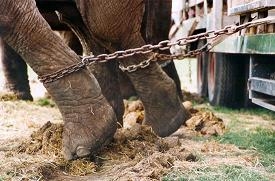 OK so perhaps the title should be “Assumed Constraints and Elephant Thinking” but lets go with it as it stands. I’m pleased the new blog is up and running now and I’m not going to set myself any targets to write a blog a week or anything silly, I’m going to write when I think I’ve got something worth sharing or to help me think…. simple.
OK so perhaps the title should be “Assumed Constraints and Elephant Thinking” but lets go with it as it stands. I’m pleased the new blog is up and running now and I’m not going to set myself any targets to write a blog a week or anything silly, I’m going to write when I think I’ve got something worth sharing or to help me think…. simple.
Well I’m doing lots of thinking at the moment prompted by things that are happening at work, my experiences at the recent LnD Connect Unconference and the conversations I’ve been having with my trusted PLN. Inspiration is all around us and I’m feeling pretty inspired at the moment. I’ve been inspired and encouraged by the recent comments on my first post and the comments from @Burrough & @Perrytimms is what has prompted me to write this.
@Burrough started things off with his comment;
I think the key point that Damian (@Dames20) and Perry have identified is how kind of events only attract the “enlightened” minds, so unless the people who attend go away with some kind of common purpose that translates into action, they don’t result in any wider change. Even if they do it’s asking a lot for 50 people from disparate backgrounds to change a profession.
Why?
Why is it asking a lot for 50 people from a different backgrounds to change a profession? This for me is an assumed constraint that we all suffer from, why can’t one person let alone a small group of people change their methods, approaches to organisational learning or even a whole profession. It’s not really that small, yes there were 30 + people at the unconference but there are 1000’s across the globe all working towards the same thing. Change is in the air and you can either be blowing the gale or be getting blown away.
It was an assumed constraint of mine that I had nothing to say or that no-one would be interested in what I had to say. Who am I to share my thinking and things I’ve been doing? I’ve been in L&D for a mere 6 years so I surely can’t contribute and drive change can I? Wrong, of course I can just like you can, and this links to another of the comments by @Burrough
So it’s more about personal leadership, spreading the word, walking the walk and showing what can be done. But as you and I both know that’s a long and hard road to tread in some organisations.
Yes I couldn’t agree more, it’s been hard work and we’re still on the journey. A journey that has meant at times you are the lone voice and the only person who sees value in doing things differently. Personal leadership for me, is about believing in what you believe in and if others see a genuine passion when and how you walk the walk then they will follow that passion and belief, irrelevant if you’re in a position of power or ‘a leader’. Leadership comes from within and everyone in L&D & HR right now should see themselves as a leader and role model. A leader of change within organisations and a role model for showing what can be done.
I do think elephant thinking affects our professions (and not just ours I hasten to add), in that there are those who are still chained to the post. Blissfully unaware of the possibilities, of the change they could drive and be a part of. Then there are those who may be aware of the possibilities but because of their assumed constraints do nothing about it, “I can’t do that”, “that won’t work”, “I don’t do technology”, “social media is a distraction”, “My organisation won’t / can’t / wouldn’t” – take your pick. It all leads down the same path… the same path that you’ve been going down for the last umpteen years.
For some (maybe the few) the elephant has snapped the chains and bolted, it’s skipped the circus and is now making its’ large presence felt in many ways at unconference events, conferences, tweet ups, tweet chats, in communities and through blogs. The elephants are pretty good at sharing what they do and are making their presence felt so you can imagine what a herd of elephants can do when they’re together – they have the potential to trample old mindsets and assumed constraints like trees in the jungle.
Enough with the elephant analogy but @Perrytimms made me smile when he said;
I’m in this game to create a better future….
I hope every Learning & HR Professional feels like this, feels like they are part of something special and has a chance to change a profession. We certainly aren’t going to do that whilst we think we can’t have an impact or we’re still chained to the post.
Lets get rid of those assumed constraints, lets be brave, lets role model, lets be prepared and recognise it will take some time but let’s keep sharing what we’re doing with as many people as we can in as many different ways as we can. Lets put a stop to elephant thinking and recognise and celebrate new L&D thinking instead.
The only question to ask yourself is are you in this game to create a better future or are you still chained to the post?

Pingback: The long road to improvement « Learning@learning
Mike – Like the analogy & blog! I think self-limiting beliefs & lack of engagement with purpose are real issues with many practitioners. Perhaps ironically, isn’t it within the remit of L&D to help people with such issues…
Also, your post has reminded me of the Diffusion of Innovation. I think what we’re seeing at the moment is the movement of innovators and early adopters. The two big “unknowns” for me are what is the tipping point (after which there is relatively rapid adoption) and which technologies (& beliefs?) will fail. Any thoughts?
Hi David, thanks for your comment. I first came across the Diffusion of Innovation from Simon Sineks TED Talk “How Great Leaders Inspire Action” ..
…as well as the Diffusion of Innovation he discussing that starting with ‘WHY’ is more important than the what and the how. I can’t help link this to the ‘self-limiting beliefs and lack of engagement with purpose” e.g. If practioners start with What – “I deliver training” then the How – “classrooms, workshops, workbooks, handouts” because the Why is “because it’s my job” then this is the problem and why there has been a lack of progress. If practioners started with the WHY and the answer is – “because I want to make a difference in organisational learning, develop new methods and evolve how people view learning and can perform. I want to enhance ways people can communicate and collaborate and create a better future” then who would you rather work with or find more inspiring?
You’ve reminded me of a conversation a while ago I had with some nice chaps around innovation and early adopters and I think there is something in this worth sharing. Will get my thinking cap on.
Simon Sinek is great and there is definitely something here for L&D starting with “Why” – perhaps this could be a session at the next unconf?
The other “awareness” here that is sticking with me is if we are innovators & early adopters when will we know if what we have will fail? When will we know if what we have will succeed because we’ve passed the tipping point?
No answers (!) but feels like something we need to be very aware…
Great post Mike! Also love the analogy you are using. I agree that we can all make a difference even if there are only a few of us.
My ‘thing’ is about leaving a legacy. When I work with people I want to leave something that lasts, whether that be changes in individual, team or organisational performance. Thankfully I feel confident I have managed to achieve this so far.
What I am taking from your blog is that you want to create a legacy that reaches further than individuals, teams or organisatons. It seems to me that you want to leave that legacy in a profession. That sounds inspirational to me and if you will have me, I would love to sign up and join you!
Phil thanks for your comment and I’ve been thinking about it for a couple of days on how to reply. I think the innovators post has generated some thought on this also as I can’t say what I’m trying to do with networks is my legacy. My ‘moment’ came in 2008 at Learning Technologies conference when I watched Jane Hart do a presentation on social learning and using networks in organisations. It made sense, something clicked and I went back and the next day set up a Ning network and have been working in and been part of networks / communities ever since. Is it Jane’s legacy then? Perhaps, perhaps not as these things were happening before 2008 I’m sure. Whoever’s legacy it is I agree with you when you say “When I work with people I want to leave something that lasts, whether that be changes in individual, team or organisational performance.” I’m in the same boat and I’m not on this world to make up numbers, I want to leave something that lasts 🙂
Pingback: You are NOT an innovator | The Learning Asylum
Great blog Mike! I absolutely agree and you ARE definitely an innovator. If we are going to be the BEST then we all need to taken responsibility for our own development and we have a great opportunity to role model this.
Thanks for taking the time to add your thoughts Karen and I agree with you ownership and personal (self) leadership is key to be able to move away from using only top down approaches in L&D. There must also be an education piece of people that matter from stakeholders to learners of how the other way works and the key components of making lasting change.
If you look at large corporates (just as an example) where traditional approaches to L&D roles, models and practices are present plus command & control mindsets or parent child relationships between managers and staff. Any change here and challenge to the status quo would be seen as and called innovation as its so different.
Whatever we call it we still need to do it and not give up and take the people we work with on the journey no matter how long it takes
Pingback: Say what you see | The Learning Asylum